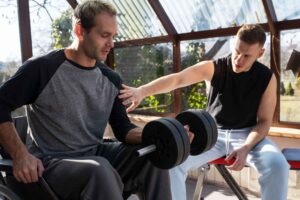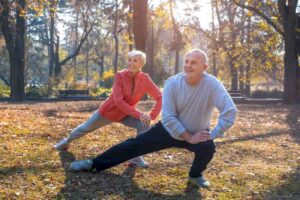Introduction
Azing is a natural process, but being strong, active and independent after 50 is possible with the right habits. One of the best ways to maintain health and dynamics is strength training after 50. Many people think that lifting weight in the gym is the only way to make strength, but it is not true. You can improve muscle strength, bone health and balance with no-GIM exercise at home.
This guide will show you how to start strength training after 50 With a simple, no-recognition Biginer Plan. Whether you are completely new to fitness or returning after years of inactivity, you will learn how to exercise safely, avoid injuries, and enjoy the benefits of a strong body.
The Benefits of Strength Training for Adults Over 50
Shakti training plays an important role for older adults as it helps to slow down the natural damage of muscle mass – known as Sarcopenia – and a certified individual trainer and doctoral student at Miami University, Kerry Strand of Kerry Strand says the decline in bone density coming with age.
“As we grow up, our bodies naturally lose muscles and strength, and if we do not take steps to address it, it can cause loss of freedom and everyday task,” Strand explains. “For older adults, maintaining strength, strength and muscles is not just beneficial – it is necessary to stay active and stay well as long as possible.”
Most of the danger of losing type II muscle fibers lies in losing muscle mass, since these fibers are responsible for explosive movements like standing up from a chair,” explains McCarthy. “That simple action may not seem like much, but it’s actually a powerful move.
This is why focusing on type II muscle fibers becomes especially important as we age. The good news is that strength training after 50 can directly target these fibers through a structured routine, helping you maintain strength, mobility, and independence instead of losing them.
Beginner-Friendly, No-Gym Strength Training Plan
You don’t need expensive equipment or a gym membership to begin. Your body weight, a sturdy chair, or even water bottles can serve as tools for strength training after 50.
1. Chair Squats
Stand in front of a chair with the shoulders of the feet.
Reduce your body as if sitting down, stand again.
Representative: 8-10 times.
Benefits: Strengthens the legs, hips, and improves balance.
2. Wall Push-Up
Facing a wall, extended the weapon, and hand on the wall.
Fold the elbow, bring the chest closer to the wall, then push back.
Representative: 8–12 times.
Benefits: The chest, shoulder and hand strength form without pressure on the joints.
3. Step-Up
Use a strong step or ladder.
Step with one leg, then the other, and step down.
Representative: 8-10 each leg.
Benefits: Strengthens the legs, improves coordination and heart health.
4. Sitting Foot Extension
Sit on a chair with a flat of the feet.
Extend a leg directly, hold for 3 seconds, then reduce.
Representative: 8–12 each leg.
Benefits: strengthens quadriseps and improves the stability of the knee.
5. Bicep Curl with Water Bottles
Hold the bottles of water in each hand.
Fold the elbow and curl upwards, then reduce slowly.
Representative: 8–12 times.
Benefits: Tons strengthens weapons and grip.
6. Standing Calf Raises
Stand with the shoulders of the feet.
Raise your heels, stand on the toes, then reduce slowly.
Representative: 10-15 times.
Benefits: The calf manufactures power and improves balance.
7. Bird-Dog (Core Stability)
On the hands and knees, expand one hand to the back and back leg.
Hold for 3-5 seconds, then switch to the sides.
Representative: 6-8 each side.
Benefits: Strengthens the core, improves posture, reduces back pain.

✅ Try this plan 2-3 times per week, leave a rest day between workouts. Over time, you will notice increased power, energy and dynamics.
Nutrition and Recovery for Better Results
- Protein Consumption: Assists in regenerating muscles. Include lean meats, fish, eggs, beans, and dairy.
- Calcium and Vitamin D: Important for bone health. Incorporate milk, leafy greens, and sunlight.
- Hydration: Drink adequate water throughout the day.
- Sleep Enough: Maintain 7-8 hours to promote muscle recovery.
- Stretch and Work on Mobility: Keep joints supple and reduce stiffness.
Common Mistakes to Avoid
When starting strength training after 50, beginners often make mistakes that can lead to injuries or lack of progress. Avoid these pitfalls:
- Skipping warm-ups: The muscles require preparation before activity.
- To do very soon: Gradually progress to avoid stress.
- Ignoring core strength: A strong core prevents back issues.
- Not to relax enough: The muscles require time to repair and strengthen.
- Comparing yourself to young athletes: focus on your progress.
Remember, the goal is long -term health, not quick results.
How to Start Strength Training
Start with Body-Weight Exercise
If you are making a beginning, you should start with movements using your body weight (squats, wall push-ups, glut bridges, step-ups). These will allow you to build the foundation of strength before starting adding additional resistance.
Use Proper Technology
The technique is more important than the amount of your weight that you can lift. At slow, practice controlled movements and be vigilant to your seat. If you are uncertain about your form, seek help from a trainer or use a good video tutorial.
Start Light and Speed Yourself
Use water bottles such as light dumbbells, resistance bands, or household items. Once your muscles are adapted to new stress, add progressive resistance. The purpose is progress, not to lift more weight.
Traine Major Muscle Groups
Be sure to work in areas of all major torso and organ muscles; Legs, middle and lower parts, chest, shoulders, weapons and core. This will keep you balanced and hurt-free, while the overall ceremony will also improve.
Keep the Workout Short and Consistent
Start with 2-3 sessions per week per week and when you are ready, you can increase the intensity or frequency of the workout.
Warm-Up and Cool-Down
Always prepare your body to move forward; End light cardio or dynamic stretching, and light stretching before training.
Listen to Your Body
Initially agony is specific, not pain. Take a rest day when needed, and give your body time.
Staying Consistent and Motivated
Building a new habit can be challenging, but consistency is key to success. Here are ways to stay motivated in your strength training after 50 journey:
- Set small goals: Start with a short -term, obtainable milestone.
- Track progress: Place a workout journal to see improvement over time.
- Find out the workout Buddy: Exercising with a friend gives fun and accountability.
- Celebrate achievements: Award yourself for reaching milestones.
- Be positive: Note how much better you feel, not just physical results.
Safe Exercises for Over 50
- Bodyweight squats: Great to strengthen the legs and improve balance. If necessary, you can hold on a chair or wall for support.
- Wall push-ups: A soft upper-body exercise that strengthens joints, shoulders and weapons without stress to joints such as floor push-ups.
- Gum bridge: Help with asana and stability strengthens the hips, glutes, and lower back.
- Stairs: Using a low step or strong platform, step up and down to create foot strength and improve coordination.
- Sitting leg extensions: Perfect for strengthening quadriseps (front thigh muscles) while protecting the knees.
- Bicep curl with light weight or band: Strengthens weapons and helps in daily tasks such as lifting grocery bags.
- Standing calf arises: Makes the strength of the low leg and supports balance when walking or climbing on the stairs.
- Bird-dog exercise: On the hands and knees, while the core extended to the arms and feet of the hands and feet improves the core strength and stability.
- Kursi Yoga or Stretching: Helps with flexibility, reduces hardness, and supports joint health.
- Walking or light cardio: A low -impact method to keep the heart healthy, patient and support overall fitness.

Final Thoughts
Starting strength training after 50 doesn’t have to be intimidating. You do not need gym, expensive equipment, or prolonged exercise. Simple, safe, with no-GYM routine, you can build strength, improve balance and support your long-term health.
It was never late to control your fitness. Start with a plan of beginning, be consistent, and listen to your body. Over time, you will achieve energy to confident, freedom, and life to enjoy life.
So, why wait? Your strongest years can still be ahead of you – still start today!
How to link it: “For more expert advice on nutrition you can visit this page.”
- Explanation: The link points to a specific and authoritative source, making your content more trustworthy.





